Dairies, water-use and the drought
Chris Brunner, April 7, 2014
While the storms of March and April were much-welcomed, California remains in the grip of one of the driest years in the state’s recorded history. The Sierra snow pack, responsible for providing one-third of California’s water needs, is only 32 percent of normal. On average the state’s major reservoirs, responsible for supplying fresh drinking and irrigation water, sit just at or below half full. In January, Governor Brown declared a drought state of emergency. The fact that this is actually the third year of drought has made a critical situation even more dire.
The state’s interconnected water system (developed from the 1930s through the 1970s) was never designed to the accommodate California’s current 38 million residents. Perhaps the sole saving grace of the severity of this drought has been to stimulate a long overdue discussion on the adequacy of California’s water storage and delivery infrastructure and how to best upgrade it.
With less than one percent of the population claiming farming as an occupation, it is understandable that urban consumers, the majority of the state’s residents, are concerned about agriculture’s stewardship of California’s precious water resources. It should also come as no surprise that as water has become scarcer and more expensive over the decades, farmers have had both societal and economic reasons for conservation.
According to the Public Policy Institute of California, farmers applied 23 percent less water to their fields in 2005 than in 1980, about the time total agricultural water use peaked. Yet even with less water over this same period, average crop yields have increased by more than 40 percent.
Of all of agriculture, dairies are the undisputed authorities on water conservation and recycling. On the average dairy the same ounce of water is typically used four times. First to help cool the milk to refrigeration temperatures, second to help clean the cows and the stainless steel milking equipment, third to wash out the barns and finally as irrigation water to raise forage crops like hay and corn for silage
Research by Cornell University (Capper, 2009) had calculated that, in part because of these recycling and conservation efforts, today it takes 65 percent less water to produce the same gallon of milk that it took U.S. dairy farmers back in 1944. In other words, producing a glass of milk today uses about a third of the water it did during the Franklin Roosevelt administration.
This miracle of conservation is also due to optimizing milk production per cow. Contrary to popular opinion, there are actually far fewer dairies and dairy cows now then there were a half century ago. Since the 1940s the number of U.S. dairy farms has decreased from more than 4 million to 65,000, with the number of dairy cows declining from 25 million head to just 9 million.
This decades-long focus on water conservation and recycling means there is scant wiggle-room for emergency water use reductions on dairies. Cows still need to be watered, equipment still needs to be sanitized and milk still needs to be cooled. How severely the drought will affect California dairies depends primarily where the dairy is located and how the farm sources its water supplies. Some producers have already needed emergency assistance to provide drinking water for cattle as their wells and creeks have dried up.
About the only thing farmers can do to reduce water use is to limit irrigation by letting forage acres lay fallow, something that is already happening on many dairies. With forage acres taken out of production, feed supplies will become increasingly limited, driving up the cost of available feed. This will exacerbate the already extremely high feed prices, prices which have spiked over the last five years. Feed costs represent about 65 to 70 percent of dairy operational costs, so feed prices have a direct and profound effect on dairy profitability. In fact, it was the combination of high feed prices and loss of international markets during the current recession which caused California to lose some 500 dairies since 2008, about a quarter of the state’s family-owned operations. The severity and duration of the current drought will determine if additional dairies will be forced to close in the coming months.
The University of California has taken an all-hands-on-deck approach to assisting California’s farmers during the drought. The Department of Animal Science, the School of Veterinary Medicine and UC Cooperative Extension have united together under the umbrella of the dairy industry’s collaborative California Dairy Quality Assurance Program to formulate drought guidance. The outreach plan includes assistance in locating and applying for disaster relief funding and conducting drought management workshops. For more information visit the CDQAP’s drought information page.
Dr. Payne shares comments on the economic pressures faced by family farms in a story by Danielle Venton of NPR affiliate station KRCB, North Bay Public Media. To listen to the complete broadcast Click Here.
Dr. Michael Payne is a veterinarian working with UCD’s Western Institute for Food Safety and Security and Director of the California Dairy Quality Assurance Program.

